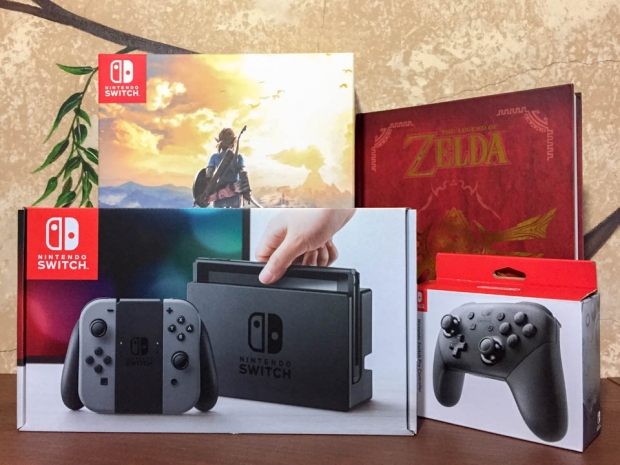Index
Conclusion
Nintendo appears to have a solid release on its hands with the Switch this generation, having released the first hybrid console that will ensure many years of home and portable gameplay. An interesting question to ask is whether Wii U owners will upgrade more quickly than Nintendo DS/DSi owners, considering the console’s larger audience reach and flexible usage options.
Tablet
The tablet itself is strikingly reminiscent of Nvidia’s Shield Tablet series, and this is to be expected due to a similar design housing with a Tegra X1 processor. Admittedly, our biggest criticism is that the console’s larger bezels have subtracted away from its aesthetic value, especially with 2017 being the dawn of an age of borderless smartphones and tablet designs from several major OEMs (see: Samsung Galaxy S8, upcoming iPad Pro). Of course, some concept art shows what the Switch would look like with a 15 percent larger display size, and it is not impossible to envision an eventual refresh later down the line where the body of the tablet attaches completely flush with the Joy-Con controllers. The advantage would be twofold – more surface area for a larger display size, and a body width closer to the PlayStation Vita’s 7.23 inches (183.6mm).
Controllers
The Joy-Con controllers are fit with a lightweight and overall good build quality, very similar in nature to the Sony’s PlayStation Vita, but without the squeaky “L” and “R” shoulder buttons that can be fixed by loosening the screws. Each Joy-Con has a battery life of 20 hours, while the previous Wii Remotes used in conjunction with the Wii MotionPlus can typically last around 25 hours. In other words, a docked Nintendo Switch can be used these controls for almost a full day’s worth of non-stop gaming in the event of a marathon or similar activity.
The included Joy-Con Grip controller is a neat idea reminiscent of a squared-off GameCube controller, though it is not necessarily the most comfortable controller design offered over the past twenty years. For casual gaming, we strongly recommend either using the Joy-Con controllers separately in each hand, or considering the purchase of the Nintendo Switch Pro controller ($70). In terms of weight and size, the latter is more in line with Sony’s DualShock 4 and provides a much more comfortable grip with less thumb reach to each individual joystick and button.
Functionality
Nintendo is set to restructure its DS lineup’s market share over the next few years as a result of the Switch entering the scene, and there is little doubt that each console will include its own original games. Nintendo President Tatsumi Kimishima says that the company will continue to operate both businesses separately and in parallel, as the 3DS has unique characteristics that differ from the Switch.
The three different controller options (individual Joy-Cons, Joy-Con Grip, and Pro controller) also give the tablet a flexible range of options for interaction, and each includes the Wii and Wii U’s signature motion feedback mechanisms. For portable use, this is one area where the Switch has an upper hand over the PlayStation Vita’s integrated Sixaxis motion sensor. Sony’s inclusion of a rear touchpad on its console gives a handful of games an upper edge in tactile motion feedback, but Nintendo has instead decided to adopt untethered virtual motion controls for a wider range of in-game uses.
Another important point on mixed usage is that switching from TV Mode to handheld mode is fairly quick and seamless. The ability to dock the console into several rooms for use with multiple televisions, however, will remain a luxury for those who can afford an additional $90 per dock.
Performance
The Nintendo Switch, just like the Shield Android TV based on the same Tegra X1 SoC, is capable of hitting a target of 60fps, though most games will likely be optimized around 30fps using dynamic scaling algorithms. Yes, some games on the Tegra X1-based Shield Android TV can run anywhere between 40 to 60fps, but consider that this device isn’t portable and requires a tethered TV display. On the other hand, Nintendo has made performance adjustments necessary to balance texture efficiency with battery life. Likewise, the PlayStation Vita is capable of the same 60fps framerate, though most of its titles operate around 30fps. As for the bottom-end, games like The Legend of Zelda: Breath of the Wild on the Switch are framerate-locked at 20fps and to prevent unnecessary stuttering.
Launch games
Of course, the biggest and most important factor of purchasing any new console is the number of audience-engaging titles it affords during launch season. With the Nintendo Switch, there are only three or four decent titles aside from its blockbuster hit, The Legend of Zelda: Breath of the Wild. These include Fast RMX – a great racing game similar to Wipeout on PlayStation and F-Zero on SNES – Shovel Knight, a re-release that encapsulates the same formula from 16-bit era games like Castlevania – and Snipperclips – an interesting physics-based puzzle game developed in an anti-Mario Party fashion that allowing players to cooperate between two characters named Snip and Clip.
Pricing
The 5-inch Nintendo Switch is currently available for $299 from major retailers worldwide. In comparison, the 5-inch PlayStation Vita (Wi-Fi) is available for $249, the 8-inch Shield Tablet K1 (Kepler) is $199, and the 4.2-inch Nintendo DSi XL is currently offered at $169. With its inclusion of flexible controller options, USB-C charging, lightweight and respectable build quality, the Nintendo Switch introduces enough feature advantages and a decent leap in game quality over the DS lineup to justify the additional price. However, we could see this drop within the next year once the company builds out its larger arsenal of independent, creative, and best-selling hits for the platform. Thankfully, there will be no region locking with the world’s first hybrid home-portable console, and this importantly allows it to maintain an equal playing field with Android and iOS development in the coming years.




